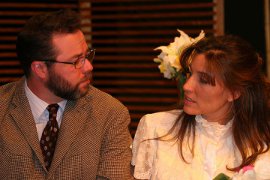 Directed by David Bonde, the Curtainbox Theatre Company's Hedda Gabler starts off on a happy, frivolous tone. As George Tesman (Reader employee Mike Schulz) tells his Aunt Julie (Corinne Johnson) about the honeymoon from which he's just returned, they share smiles and hopeful, knowing glances. Yet several minutes into this, during Tuesday night's performance, I was a bit bored, wondering why the Curtainbox - which had consistently produced weighty, thoughtful material - was suddenly producing a script filled with such lighthearted but fundamentally pointless drivel.
Directed by David Bonde, the Curtainbox Theatre Company's Hedda Gabler starts off on a happy, frivolous tone. As George Tesman (Reader employee Mike Schulz) tells his Aunt Julie (Corinne Johnson) about the honeymoon from which he's just returned, they share smiles and hopeful, knowing glances. Yet several minutes into this, during Tuesday night's performance, I was a bit bored, wondering why the Curtainbox - which had consistently produced weighty, thoughtful material - was suddenly producing a script filled with such lighthearted but fundamentally pointless drivel.
And then Kimberly Furness made her entrance.

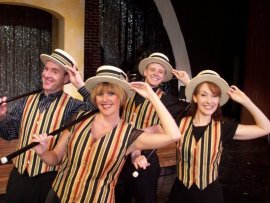
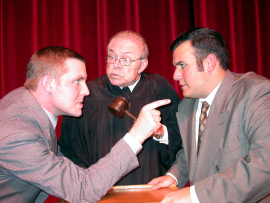 As its storyline was inspired by 1925's notorious Scopes "Monkey Trial," and its original 1955 presentation a response to McCarthyism, Inherit the Wind is one of those theatrical titles that wears its badges of Importance and Social Relevance on its sleeve. And so it isn't until you see the play (or see it again) that you realize (or remember) just how entertaining it is; Jerome Lawrence's and Robert E. Lee's courtroom drama is less a lecture or a harangue than a juicy, if sentimentalized, episode of Law & Order.
As its storyline was inspired by 1925's notorious Scopes "Monkey Trial," and its original 1955 presentation a response to McCarthyism, Inherit the Wind is one of those theatrical titles that wears its badges of Importance and Social Relevance on its sleeve. And so it isn't until you see the play (or see it again) that you realize (or remember) just how entertaining it is; Jerome Lawrence's and Robert E. Lee's courtroom drama is less a lecture or a harangue than a juicy, if sentimentalized, episode of Law & Order.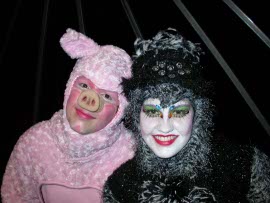 If I counted correctly, St. Ambrose University's Charlotte's Web and Quad City Music Guild's Miracle on 34th Street featured a grand total of five dozen actors between them. Yet the true stars of both musicals weren't among those individuals; despite boasting an excellent Wilbur the Pig in Ryan Westwood, Charlotte's Web was primarily a triumph for set designer Kristofer Eitrheim, and Miracle belonged to no one so much as scenic artist Bob Williams. Eitrheim's and Williams' contributions were dazzling, and my only regret in raving about their work now is that it's too late for new audiences to admire it. (Both presentations ran only one weekend and closed on December 2.)
If I counted correctly, St. Ambrose University's Charlotte's Web and Quad City Music Guild's Miracle on 34th Street featured a grand total of five dozen actors between them. Yet the true stars of both musicals weren't among those individuals; despite boasting an excellent Wilbur the Pig in Ryan Westwood, Charlotte's Web was primarily a triumph for set designer Kristofer Eitrheim, and Miracle belonged to no one so much as scenic artist Bob Williams. Eitrheim's and Williams' contributions were dazzling, and my only regret in raving about their work now is that it's too late for new audiences to admire it. (Both presentations ran only one weekend and closed on December 2.)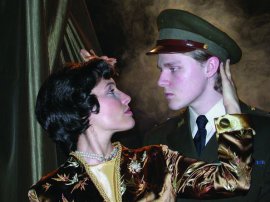 Before Friday night's presentation of Crème de Coco commenced, St. Ambrose University theatre professor Corinne Johnson briefly took the stage, and related how proud she was of the evening's entertainment - a world premiere by Broadway playwright William Luce, directed by Broadway veteran Philip William McKinley (both of whom were in attendance). As theatrical coups go, this one was way up there.
Before Friday night's presentation of Crème de Coco commenced, St. Ambrose University theatre professor Corinne Johnson briefly took the stage, and related how proud she was of the evening's entertainment - a world premiere by Broadway playwright William Luce, directed by Broadway veteran Philip William McKinley (both of whom were in attendance). As theatrical coups go, this one was way up there.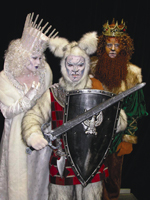 "I'm the mom of the theatre department," says St. Ambrose designer Dianne Dye during an afternoon spent in the university's costume shop. "If people have a problem, or when they just want to gossip, here's the place to come."
"I'm the mom of the theatre department," says St. Ambrose designer Dianne Dye during an afternoon spent in the university's costume shop. "If people have a problem, or when they just want to gossip, here's the place to come."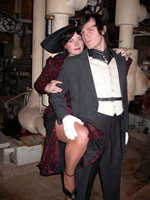 During Bertolt Brecht's The Threepenny Opera - the German dramatist's revolutionary musical-comedy collaboration with composer Kurt Weill - we're meant to feel uneasy. With its cast of beggars and rogues, obliteration of the fourth wall, and refusal to cater to conventional audience expectation (the songs here, devoid of proper finales, don't so much finish as stop), The Threepenny Opera is a fascinating, deliberately alienating piece. Our enjoyment stems from how unconventional the show is, but in no traditional sense are we meant to simply like it.
During Bertolt Brecht's The Threepenny Opera - the German dramatist's revolutionary musical-comedy collaboration with composer Kurt Weill - we're meant to feel uneasy. With its cast of beggars and rogues, obliteration of the fourth wall, and refusal to cater to conventional audience expectation (the songs here, devoid of proper finales, don't so much finish as stop), The Threepenny Opera is a fascinating, deliberately alienating piece. Our enjoyment stems from how unconventional the show is, but in no traditional sense are we meant to simply like it.







